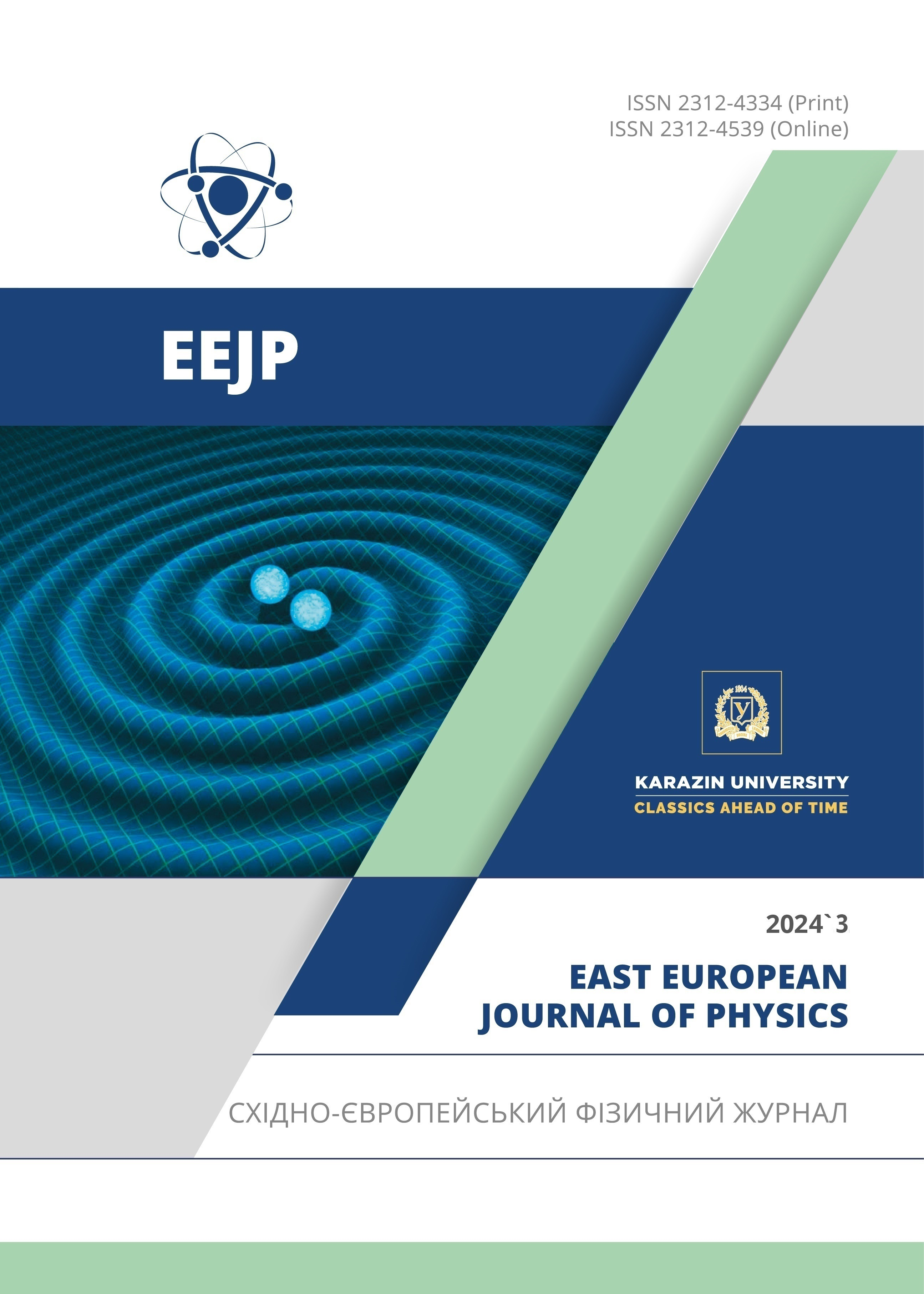Investigation of Sensitive Thermal Sensors Based on Si<Pt> and Si<Pd>
Abstract
In this work, new sensitive thermal sensors based on Si<Pt> and Si<Pd> were developed. Single-crystal n- and p-type silicon samples doped with phosphorus and boron during growth were used for the study. These samples were first doped with platinum and palladium, then subjected to ohmic contact with nickel. To manufacture temperature sensors based on n-Si˂Pd˃ and obtain an ohmic contact, this material was subjected to appropriate mechanical and chemical treatments. Metallic nickel with a thickness d = 1 μm was chemically deposited on its surface, followed by thermal annealing in a vacuum at T = 400-450℃ for t = 10 - 15 minutes. To compare the created temperature sensors, a special measuring device, a thermostat, was developed to ensure uniform heat transfer.
Downloads
References
Sh.B. Utamuradova, D.A. Rakhmanov, P.L. Tuan, A.S. Doroshkevich, R.Sh. Isayev, and A.S. Abiyev, “Studying the Influence of Proton Irradiation on the Distribution Profile of Pt and Cr in Surface Layers n-Si˂Pt˃, n-Si˂Сr˃ Using Ellipsometric Spectroscopy,” Advanced Physical Research, 6(2), 83 (2024). http://jomardpublishing.com/UploadFiles/Files/journals/APR/V6N2/Utamuradova_et_al.pdf
M.K. Bakhadyrkhanov, S.A. Valiev, S.S. Nasriddinov, and S.A. Tachilin, “Sensitive thermal sensors based on highly compensated silicon,” Electronic processing of materials, 43(6), 111 (2007). https://eom.ifa.md/ru/journal/download/752. (in Russian)
Sh.B. Utamuradova, Sh.Kh. Daliev, D.A. Rakhmanov, S.F. Samadov, and A.S. Doroshkevich, “Investigation of Radiation Defect Formation of Irradiated n-Si,” Advanced Physical research, 5(3), 183 (2023). http://jomardpublishing.com/UploadFiles/Files/journals/APR/V5N3/7.Utamuradova.pdf
Utamuradova, Sh.B., Matchonov, Kh.J., Khamdamov, J.J., & Utemuratova, Kh.Y. X-ray diffraction study of the phase state of silicon single crystals doped with manganese. New Materials, Compounds and Applications, 7(2), 93-99, (2023). http://jomardpublishing.com/UploadFiles/Files/journals/NMCA/v7n2/Utamuradova_et_al.pdf
Sh.B. Utamuradova, Sh.Kh. Daliev, A.V. Stanchik, and D.A. Rakhmanov, “Raman spectroscopy of silicon, doped with platinum and irradiated by protons,” E3S Web of conferences, 402, 14014 (2023). https://doi.org/10.1051/e3sconf/202340214014
Kh.S. Daliev, Z.E. Bahronkulov, J.J. Hamdamov, “Investigation of the Magnetic Properties of Silicon Doped with Rare-Earth Elements,” East Eur. J. Phys. (4), 167 (2023), https://doi.org/10.26565/2312-4334-2023-4-18
Sh.B. Utamuradova, Sh.Kh. Daliev, D.A. Rakhmanov, A.S. Doroshkevich, V.A. Kinev, O.Yu. Ponamareva, et al., Advanced Physical research, 5(2), 73-80 (2023). http://jomardpublishing.com/UploadFiles/Files/journals/APR/V5N2/Utamuradova_et_al.pdf
Sh.B. Utamuradova, A.V. Stanchik, K.M. Fayzullaev, B.A. Bakirov, Applied Physics, 2, 33–38 (2022). (in Russian).
N.A. Turgunov, E.Kh. Berkinov, and D.X. Mamajonova, “Decay of Impurity Clusters of Nickel and Cobalt Atoms in Silicon under the Influence of Pressure,” Journal of Nano- and Electronic Physics, 13(5), 05006 (2021). https://doi.org/10.21272/jnep.13(5).05006
Sh.B. Utamuradova, D.A. Rakhmanov, A.S. Doroshkevich, I.G. Genov, P.L. Tuan, and А. Kirillov, “Processes of Defect Formation in Silicon Diffusion-Doped with Platinum and Irradiated with Protons,” Eurasian physical technical journal, 20(3), 35 (2023). https://doi.org/10.31489/2023No3/35-42. (in Russian)
Z.T. Azamatov, M.A. Yuldoshev, N.N. Bazarbayev, and A.B. Bakhromov, “Investigation of Optical Characteristics of Photochromic Materials,” Physics AUC, 33, 139-145 (2023). https://cis01.central.ucv.ro/pauc/vol/2023_33/13_PAUC_2023_139_145.pdf
Sh.B. Utamuradova, D.A. Rakhmanov, and A.S Abiyev, “Influence of Different Types of Radiation on the Crystal Structure of Silicon Monocrystals n-Si,” East Eur. J. Phys. (2), 380 (2024). https://doi.org/10.26565/2312-4334-2024-2-47
L. So, and S.K. Ghandhi, “The energy levels of palladium in silicon,” Solid-State Electronics, 20, 113-117 (1977). https://doi.org/10.1016/0038-1101(77)90059-4
M.A. Alanazi, “Development and experimental testing of an innovative nondestructive thermal sensor utilizing the thermal interrogation method for detecting leakage in water plastic pipes,” Flow Measurement and Instrumentation, 98, 102646 (2024). https://doi.org/10.1016/j.flowmeasinst.2024.102646
O. Quldashov, Sh. Ergashev, G. Kochkorova, I. Tishabayeva, M. Тeshaboyev, and N. Tashlanova, “Stand-alone solar optic device based on aps-photodeciver,” E3S Web of Conferences, 508, 01010 (2024). https://doi.org/10.1051/e3sconf/202450801010
A.S. Rysbaev, M.T. Normuradov, A.M. Rakhimov, Z.A. Tursunmetova, and A.K. Tashatov, Journal of Surface Investigation, (11), 61 (2020). https://doi.org/10.31857/S102809602011014X
O. Kuldashov, O. Rayimdjanova, B. Djalilov, Sh. Ergashev, S. Toxirova, and A. Muhammadjonov, “Stabilization of parameters of optoelectronic devices on semiconductor emitters,” E3S Web of Conferences, 508, 01001 (2024). https://doi.org/10.1051/e3sconf/202450801001
Copyright (c) 2024 Sharifa B. Utamuradova, Dilmurod A. Rakhmanov, Afsun S. Abiyev

This work is licensed under a Creative Commons Attribution 4.0 International License.
Authors who publish with this journal agree to the following terms:
- Authors retain copyright and grant the journal right of first publication with the work simultaneously licensed under a Creative Commons Attribution License that allows others to share the work with an acknowledgment of the work's authorship and initial publication in this journal.
- Authors are able to enter into separate, additional contractual arrangements for the non-exclusive distribution of the journal's published version of the work (e.g., post it to an institutional repository or publish it in a book), with an acknowledgment of its initial publication in this journal.
- Authors are permitted and encouraged to post their work online (e.g., in institutional repositories or on their website) prior to and during the submission process, as it can lead to productive exchanges, as well as earlier and greater citation of published work (See The Effect of Open Access).








